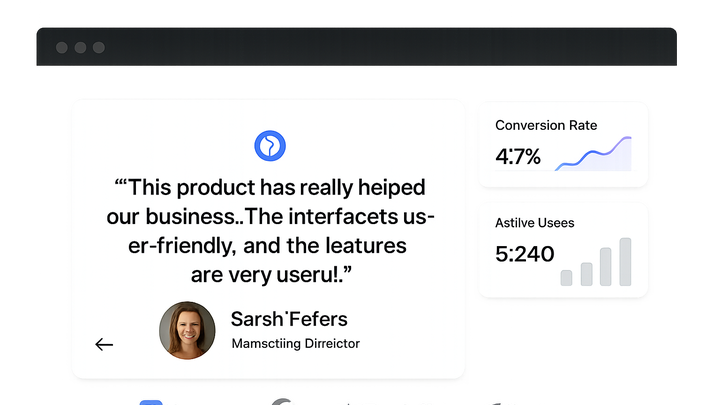Published on 2025-06-29T19:35:29Z
What is a Testimonial Carousel? Examples, Benefits, and Best Practices
Testimonial Carousel is a rotating slideshow of customer feedback excerpts on your website. In CRO, UX, and SEO contexts, it serves as social proof to build trust, guide user decisions, and improve time on site. By showcasing real customer experiences in a compact, interactive format, it can reduce bounce rates and increase conversion rates. However, improper implementation can hurt accessibility and SEO if content is hidden behind scripts. SaaS tools like Prevue.me provide actionable critiques on testimonial carousels for maximum lead generation, optimal UX design, SEO indexing, and accessibility compliance. Typically implemented with navigation controls or autoplay settings, it’s essential to maintain a balance between visibility and usability. With the right design and technical approach, testimonial carousels can enhance a website’s credibility without sacrificing performance or accessibility.
Testimonial carousel
Rotating display of customer quotes that builds trust, boosts conversions, and enhances UX and SEO.
Definition and Overview
This section explains what a testimonial carousel is and why it’s used in the context of CRO, UX, and SEO.
-
What it is
A testimonial carousel is a rotating display of customer quotes and reviews, typically shown as a slideshow, that highlights positive user experiences.
-
Why it matters
By providing social proof in a concise format, it can build trust, reduce friction, and guide users toward conversion actions.
-
Example: prevue.me audit
prevue.me evaluates your testimonial carousel to ensure it’s optimized for visibility, lead generation, and accessibility.
- Actionable critiques:
Highlights issues with content placement, design, and performance to maximize conversions.
- Seo analysis:
Checks that testimonials are implemented as crawlable text and enriched with structured data for search visibility.
- Actionable critiques:
Benefits for CRO, UX, and SEO
Explores how testimonial carousels can positively impact conversion rate optimization, user experience, and search engine optimization.
-
Building trust
Social proof from real customers reduces buyer hesitation and increases credibility.
-
Enhancing engagement
Interactive carousels encourage users to stay longer, boosting dwell time metrics important for SEO.
-
Seo advantages
Proper implementation with semantic HTML and structured data ensures search engines can index testimonials effectively.
- Crawlable content:
Ensure testimonial text is in the page’s HTML rather than loaded via inaccessible scripts.
- Structured data:
Use JSON-LD markup to annotate reviews and ratings for rich search results.
- Crawlable content:
Implementation Tips
Guidelines for designing and coding testimonial carousels that are user-friendly, performant, and accessible.
-
Semantic markup example
Use HTML5 and ARIA roles for better accessibility:
<div class="testimonial-carousel" role="region" aria-label="Customer Testimonials"> <div class="testimonial-item"> <p>"prevue.me's insights boosted our conversions by 25%!"</p> <footer>- Jane Doe, CEO of ExampleCorp</footer> </div> <!-- more items --> </div> -
Accessible controls
Include visible next/previous buttons with clear labels and keyboard focus states to support all users.
-
Performance optimization
Lazy-load off-screen testimonials and defer non-critical scripts to minimize initial page load time.
Common Pitfalls and How to Avoid Them
Identifies frequent mistakes when using testimonial carousels and strategies to address them.
-
Too many testimonials
Overloading a carousel can overwhelm users; limit to 3–5 of the most impactful quotes.
-
Hidden content
Avoid loading testimonials solely via JavaScript frameworks that hide content from search bots.
-
Auto-rotate overuse
Continuous auto-rotation can be disorienting; provide pause options and reasonable timing.
